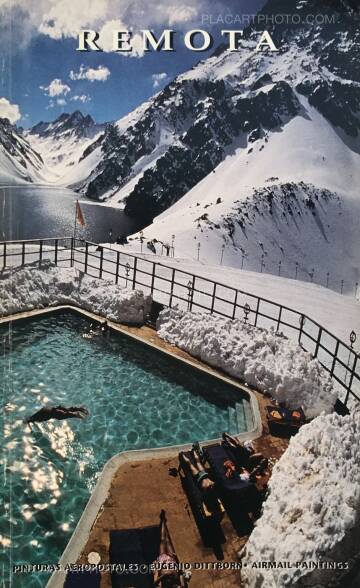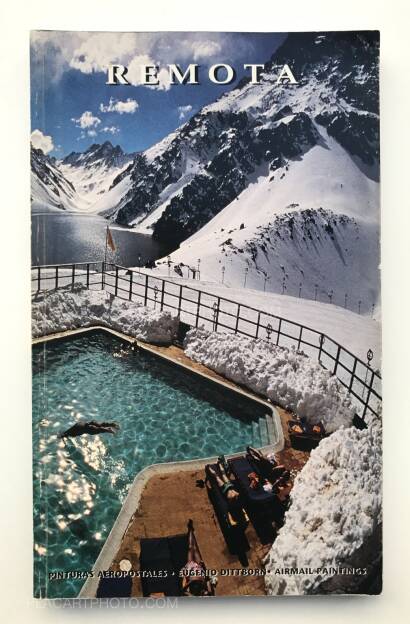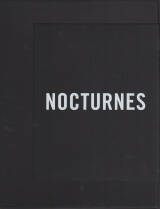REMOTA

Collective
REMOTA
Photographs: Jorge Brantmayer, Editorial Fotográfica Huber y Cia. Ltda.
Text: Guy Brett, Dan Cameron, Sean Cubitt, Roberto Merino, and others
Publisher: Publica Editores
237 pages
Year: 1997
Price: 80 €
Comments: Softcover, 217 x 350 mm.
Chilean artist Eugenio Dittborn commented on the technical-social stratification and the delay between Latin America and Metropolitan cultures through mail art (Richards 60). Dittborn made his first works called Airmail Paintings in 1984 (Dittborn 40). These works are mixed media pieces that are folded and sent through the postal service disguised as letters to be unfolded and hung with their envelopes by their recipients. (Dittborn 40). Much of Dittborn’s work documents Latin American visuality in various ways, for example, by incorporating images of local handicrafts, images of faces, child drawing, and images from other Latin American artists as subject matter (Richard 50). Dittborn made use of old photos and drawings to trigger Chilean memory through the content of his works, because pre-1973 material censored following a military coup in his native Chile (Richard 48). In Chile in 1973-1974 there was a shift in government; this was the year that military dictator Pinochet came into power. This changed the way Chile had been for decades as it was previously a democracy; a repression in freedom of speech and a fear of being tortured and killed for such speech became a part of everyday life. During Pinochet’s dictatorship in Chile, Dittborn’s work commented on power and mocked the established system by camouflaging itself, in the form of a letter it slipped into the system undetected (Rchard 61).
In Latin America the introduction of mail art began in the late 1960s and continues to flourish today with artist such as Eugenio Dittborn who has become an internationally known. Mail art encourages communicative exchanges between people from different cultures who may otherwise not have found each other in any other way. It enables the exchange of ideas and everyday problems. Mail art can be used to promote social justice and express political views (Pianowski 214). Mail art also functions as a mechanism for social commentary. In Latin America mail art has been used historically as a means to effect social and political change.
Elise Vandenbosch












more books by Collective
-
AM Projects - Nocturnes
by Collective
sold -
Strip-Poker
by Collective
sold -
Naples, visite : Naples d'un couple
by Collective
sold -
Abstracts
by Collective
sold -
Portugal livre : 20 Fotographos da imprensa contam tudo sobre ...
by Collective
sold -
REVOLUÇÃO E DESENVOLVIMENTO NO IRAQUE
by Collective
sold -
CRUZ NEGRA o el SUMARIO de la CONSPIRACIÓN CONTRA LÍBANO
by Collective
sold -
Resistencia Popular Generalizada
by Collective
sold -
25 DE ABRIL : Documento (2.a edicao, revista e aumentada)
by Collective
sold -
Lisboa Antiga
by Collective
sold -
The testimony of Nagasaki
by Collective
sold -
Chijo
by Collective
Euro 500 -
Something or anything in cityscape
by Collective
Euro 500 -
Accrochage
by Collective
sold -
Who are you ? What are you ?
by Collective
sold -
The People should teach the people
by Collective
sold -
Erotoscope
by Collective
sold -
NON
by Collective
sold -
Vêpres laquées
by Collective
sold -
1988 - The New Wave Punk Rock Explosion
by Collective
sold -
The Clash by Miles
by Collective
sold -
Crass 1977-1984
by Collective
sold -
Photo Session '82 : 10 Points Heliography/New York Diary/Light...
by Collective
sold -
Image Shop Camp vol.1 or Last!
by Collective
sold -
Nuogo Kūno teorija (The theory of a naked body)
by Collective
sold -
Die deutsche Volkspolizei
by Collective
sold -
PHENOMENA (Signed by all authors)
by Collective
sold -
The Japanese Box
by Collective
sold -
Kaihoku '68
by Collective
sold -
43° degrees North - a pillar of fire on wilderness
by Collective
sold -
10.21 to ha nanika (What is 10.21?)
by Collective
sold -
NON 1 & 2
by Collective
sold -
Okinawa
by Collective
sold -
Ryusei hanabi
by Collective
sold -
One day : ten photographers (SIGNED)
by Collective
sold -
In-between : Europe Today 2004-2005 (Complete set 14 volumes)
by Collective
Euro 500 -
Camp : Han Bunjaku
by Collective
sold -
Endcommercial : Reading the city
by Collective
Euro 90 -
A Battlefield in the city
by Collective
sold -
The testimony of Nagasaki
by Collective
sold -
3 AM
by Collective
sold -
Cronaca di una strage
by Collective
sold -
Boso Retto' 80
by Collective
Euro 220 -
Okinawa 74'
by Collective
sold -
Eigijin vol.1
by Collective
price on request -
Void Tokyo - Tokyo night vol.2
by Collective
sold -
New Topographics - Photographs of a Man-altered Landscape
by Collective
sold -
Rijeka (SIGNED)
by Collective
sold -
Suigenrin no mura ・Sokoni ita watashi
by Collective
sold -
The cow and the orchid : generic colombian photography
by Collective
sold -
1917, Images d'une révolution
by Collective
sold -
Pictures from moving cars
by Collective
sold -
NON Vol 2: Okinawa wa nigayo
by Collective
sold -
Happening du peintre Nato
by Collective
sold -
Student independent 2
by Collective
sold -
Void Tokyo - Tokyo street vol.3
by Collective
sold -
Mizugi no Yangu Redii-Tachi/ Young Ladies in Bathing Suits
by Collective
sold -
Void Tokyo vol.4
by Collective
sold -
32) Blurring policies
by Collective
sold -
69 11/13-17 Sato Hobei Soshi Toso (69 11/13-17 Fight to Stop S...
by Collective
sold -
A.M.S. (signed copy)
by Collective
sold -
Ken 1, 2, 3
by Collective
sold -
Chihei Vol.12 (Signed by 5 membres)
by Collective
sold -
D&A
by Collective
price on request -
Mittsu no eizō - ’74 Hiroshima shashinten / Trois images -’74 ...
by Collective
sold -
Mirai no sei
by Collective
sold -
COPE 5
by Collective
sold -
Eclipse | First Quarter (Limited Edt of 200)
by Collective
sold -
Shinsekai Tokyo chiho / The New World Tokyo Area
by Collective
Euro 300 -
Chihei Vol.1 (Signed)
by Collective
sold -
Chihei Vol.3
by Collective
sold -
Chihei Vol.5
by Collective
sold -
Chihei Vol.7
by Collective
sold -
Chihei Vol.8
by Collective
price on request -
Chihei 10 (Signed copy by Shunji Dodo)
by Collective
Euro 90 -
Astres noirs (first edt)
by Collective
sold -
2 ZINES Paris-Montréal / Montréal-Paris
by Collective
Euro 30 -
FOTOGRAFIAS ARGENTINAS
by Collective
sold -
Top/Bottom
by Collective
sold -
Dying Birds
by Collective
sold -
KENZINE vol.4
by Collective
sold -
Spasiba/El Djarida no.14
by Collective
sold -
Atelier REFLEXE (IV)
by Collective
sold -
Photopathe n°1
by Collective
sold -
Two Perspectives on Tokyo
by Collective
sold -
Cette façon qu'elle avait d'habiter tout son corps
by Collective
sold -
LE DEKAPSULEUR
by Collective
sold -
NUITS BLANCHES
by Collective
sold -
un nu
by Collective
sold -
BODY BUILDING BULLS (Edt of 100)
by Collective
Euro 15 -
KING HILLS (Edt of 50)
by Collective
sold -
OAOA N°3
by Collective
sold -
A set of 26 books : JE SUIS UNE BANDE DE JEUNES
by Collective
price on request -
COMPLETE 27 ZINE COLLECTION with box + 2 extra numbers by Edit...
by Collective
sold -
Bokura no tabi : Hito to hito no aida
by Collective
Euro 300 -
KENZINE vol.1 with tote bag
by Collective
sold -
Vntitled Roma XVIII
by Collective
sold -
LA VIE AU GRAND AIR
by Collective
sold -
POV
by Collective
sold -
PERIPHERIQUE
by Collective
sold -
Coffret PEGG n°3
by Collective
Euro 60 -
Poupi Whoopi 3
by Collective
sold -
Poupi Whoopi 1
by Collective
sold -
Ash
by Collective
sold -
OTANI NIEUWENHUIZE
by Collective
sold -
IMPORTANT SET OF BOOKS BY EDITIONS 1991
by Collective
sold -
A set of Eden xxx Editions books
by Collective
sold -
Skin-Hole
by Collective
sold -
Ci-gît
by Collective
sold -
FALSE FLAG #1
by Collective
sold -
FALSE FLAG #2
by Collective
sold -
The Largest in the World (Edt of 70)
by Collective
sold -
IN-SECT Vol.6
by Collective
sold -
HIRED HAND (Special edt with print)
by Collective
Euro 90 -
La ville lumière Paris, 8 Dec 2018 (Signed by both)
by Collective
Euro 28 -
Unseen Seen (Limited edtion of 150)
by Collective
sold -
Unseen Seen (Special edition of 30 copies with 2 prints)
by Collective
sold -
TERRE DE GUERRE (ASSOCIATION COPY)
by Collective
sold -
Bifuu complete set (12 vol)
by Collective
sold -
Madrid
by Collective
sold -
Sha Shin Magazine vol.1 TOKYO
by Collective
sold -
Parad 1
by Collective
sold -
Belleville sur un nuage (Special Edt/5 with 2 prints) LAST ONE!
by Collective
sold -
Chikan rush
by Collective
sold -
Hakkutsu! Tosatsu Video vol.6
by Collective
sold -
Tokyo chikan moyō
by Collective
sold -
Cosmos (Edt of 100)
by Collective
sold -
Salopp 1-4
by Collective
Euro 28 -
TEMPORADA FULGOR
by Collective
sold -
Photos 1 & 2
by Collective
Euro 1200 -
Wagaya no boku / How to protect my family against air raids
by Collective
Euro 500 -
Peeping Window 1974/ Nozoki Mado 1974
by Collective
Euro 150 -
Shudan satsuei koudou "Ashio" 1969-1971
by Collective
sold -
Le poème électronique Le Corbusier
by Collective
sold -
Workshop No. 5-8
by Collective
sold -
TRANSMETTRE PUTOVANJE PROLAZITI, SLIKE (EDT OF 150 SIGNED)
by Collective
sold -
Somo
by Collective
Euro 300 -
Raika Doumei: Pari Kaihou / Leica Alliance: Paris Full Aperture
by Collective
sold -
Watashi no onna / Volume 2 (Signed by Osamu Takizawa)
by Collective
Euro 900 -
Hiroshima, Hiroshima, Hiroshima (With yellow leaflet)
by Collective
Euro 900 -
DE-COLLAGE 6
by Collective
sold -
Paysages Photographies
by Collective
sold -
KARAOKE SUNNE - カラオケ スンネ
by Collective
Euro 50 -
Pez Suelto
by Collective
Euro 30 -
My love & Sex (WITH OBI)
by Collective
sold -
From Back Home
by Collective
sold -
LBM DISPATCH - (COMPLETE SET WITH SIGNED PRINTS)
by Collective
sold -
Dying City (COMPLETE SET OF 3)
by Collective
Euro 80 -
SPEW
by Collective
sold -
Les droits de l'homme façon Berlin-Ouest
by Collective
sold -
PINTADAS DEL REFERENDUM
by Collective
Euro 35 -
matrakken-sabbat
by Collective
sold -
LE PEUPLE n°799/800/801 - la grève générale de mai 68
by Collective
sold -
PARIS MAI-JUIN 1968
by Collective
sold -
HUNGARY'S FIGHT FOR FREEDOM
by Collective
sold -
FORME OPERAIO LE VERE RIFORME SONO LOTTE OPERAIE
by Collective
Euro 75 -
ZENGAKUREN - Struggle of Japanese students, Autumn 1967
by Collective
sold -
Non : Kangaku toso no kiroku
by Collective
sold -
Portugal ano um da revolução
by Collective
sold -
Koun soshite
by Collective
sold -
Yurusenai hi kara no kiroku - A Record of Unforgivable Days
by Collective
sold -
Shashinshū Okinawa : hyakuman kenmin no kunō to teikō
by Collective
sold -
Thai popular uprising October 1973
by Collective
sold -
Beat in Liverpool
by Collective
Euro 150 -
Koseki
by Collective
sold -
L'EUROPE ... DE L'AUTRE COTE DES ETOILES / EUROPE... ON THE DA...
by Collective
sold -
PARIS-MISERES
by Collective
Euro 45 -
PANIK BLÜTE - Bitterfeld-Report
by Collective
sold -
Die kleinen Banditen von Bogota
by Collective
Euro 60 -
LE MONDE ME DOIT L'AVENIR: 30 Ans d'histoire de l'enfant du Qu...
by Collective
sold -
Tokyo in Raiders' Ordeal
by Collective
sold -
70'S HARAJUKU
by Collective
sold -
Image Shop Camp Vol - Spécial Arles ! (YELLOW SILKSCREEN VERSION)
by Collective
Euro 100 -
Image Shop Camp Vol - Spécial Arles ! (BLUE SILKSCREEN VERSION)
by Collective
Euro 100 -
Image Shop Camp Vol - Spécial Arles ! (PINK SILKSCREEN VERSION...
by Collective
Euro 100 -
Image Shop Camp Vol - Spécial Arles ! (PINK SILKSCREEN COLLECT...
by Collective
Euro 200 -
Image Shop Camp Vol - Spécial Arles ! (BLUE SILKSCREEN COLLECT...
by Collective
Euro 200 -
Image Shop Camp Vol - Spécial Arles ! (YELLOW SILKSCREEN COLL...
by Collective
sold -
Image Shop Camp Vol - Spécial Arles ! (FANZINE VERSION)
by Collective
sold -
donner à voir (SIGNED BY BOTH ARTISTS)
by Collective
Euro 400 -
MC HOTEL Tokyo (with envelop)
by Collective
sold -
JW ANDERSON MS21 WRS21
by Collective
Euro 150 -
JW ANDERSON WS21
by Collective
sold -
Eye/LOEWE/YOU (SS 2022, issue 16)
by Collective
sold -
Albert Elbaz, Lanvin
by Collective
sold -
After & Before: Documenting the A-bomb
by Collective
sold -
i-D FASHION MAGAZINE N°3
by Collective
sold -
Minamata
by Collective
sold -
Voyeur neighbor (edt of 60)
by Collective
sold -
ISRAEL DEFENCE FORCES THE SIX DAY WAR
by Collective
Euro 75 -
Cœur en chasse (Signed)
by Collective
Euro 45 -
HIKARI 2024 (Edt of 50)
by Collective
sold -
Chihei Vol.2
by Collective
Euro 200 -
Chihei Vol.4
by Collective
Euro 900 -
Chihei Vol.6
by Collective
Euro 500 -
Chihei Vol.9
by Collective
Euro 500 -
ARALIK
by Collective
Euro 150 -
Poème et Photo
by Collective
Euro 60 -
Now, Look at This! Stage Photographs of Tenjo Sajiki Theatrica...
by Collective
sold -
ART WORKS 18 vol.3 n.5 (Edt of 150, signed and numbered)
by Collective
Euro 150 -
Nandarou Kurashiki / なんだろう倉敷
by Collective
Euro 400 -
THE VILLAGE CRY
by Collective
Euro 35 -
No Joke
by Collective
sold -
Effect Twin (ONLY 75 COPIES)
by Collective
sold -
Far from Home
by Collective
Euro 30 -
Invisible cities (edt of 50)
by Collective
sold -
Landscape.
by Collective
Euro 30 -
Workshop No.7 (Signed)
by Collective
Euro 160 -
MUSES (with obi)
by Collective
sold -
Japanese Photography Magazines, 1880s to 1980s
by Collective
sold -
women and other visions
by Collective
sold -
ALBUM DE FRANCE
by Collective
Euro 250 -
JP_ EN Issue.1 & Issue.2
by Collective
Euro 45 -
LIVE MATCH (Complete set of 3, signed and numbered of only 50)
by Collective
sold -
chic pas cher (first edition)
by Collective
sold -
EGOÏSTE N°9
by Collective
sold -
EGOÏSTE N°10
by Collective
Euro 70 -
THE SCRAP
by Collective
sold -
THE SCRAP
by Collective
sold -
Floating Worlds
by Collective
Euro 35 -
CLASSON (Signed by both artists)
by Collective
Euro 300 -
A.M.S. (Type A, Edt of 200)
by Collective
Euro 75 -
COMPILATION TOKYO (EDT OF 50)
by Collective
Euro 150 -
SPEW II
by Collective
Euro 100 -
100 Bilder (SIGNED by all)
by Collective
sold -
Indicier/Indications
by Collective
Euro 75 -
Chili: 82 photos. Documents Gamma
by Collective
sold -
BODY AS PACKAGING
by Collective
Euro 160 -
One Night Carnival : CAN YOU STOP US?
by Collective
sold -
Kono chijo ni wareware no kuni ha nai
by Collective
Euro 350 -
HANABI #1 (Edt of 300)
by Collective
sold -
Paris Iridescent
by Collective
Euro 35 -
PROVOKE MAGAZINES (BACK IN STOCK)
by Collective
Euro 100 -
Brutal (signed)
by Collective
Euro 45 -
Za Bosozoku / The Bosozoqu
by Collective
sold -
Waru ! / British Rock Style
by Collective
Euro 120 -
Sex Pistols Cut-Up!
by Collective
sold -
I Wanna be me
by Collective
sold -
HIT COMMUNICATION MAGAZINE (VOL 1)
by Collective
Euro 150 -
Eizo no Gendai (RARE COMPLETE SET WITH OBI)
by Collective
price on request
more books tagged »latin american« | >> see all
-
Del reverso de las imágenes (Signed)
by Paolo Gasparini
sold -
Vi Vendo (dedicated to Cartier Bresson)
by Pedro De Moraes
sold -
Los Cohetes duraron todo el dia
by Pedro Meyer
Euro 500 -
Buenos Aires Buenos Aires
by Alicia d'Amico & Sara Facio
sold -
La Casa Que Sangra (Signed)
by Yael Martinez
sold -
Chile o muerte (STILL IN SHRINK WRAP)
by Armindo Cardoso
Euro 900
Books from the Virtual Bookshelf josefchladek.com


























































































































































































































































_;jpg)


 Facebook
Facebook Instagram
Instagram